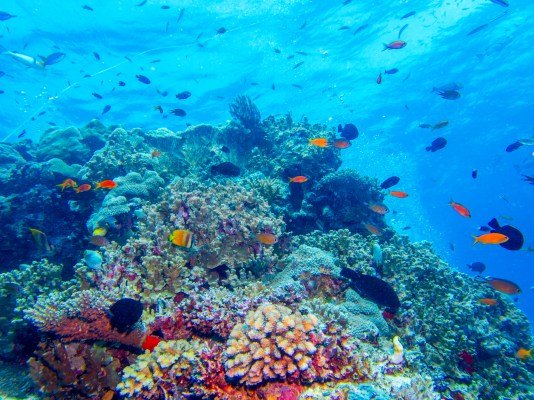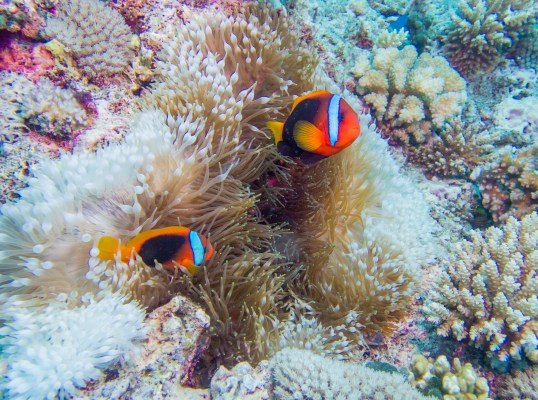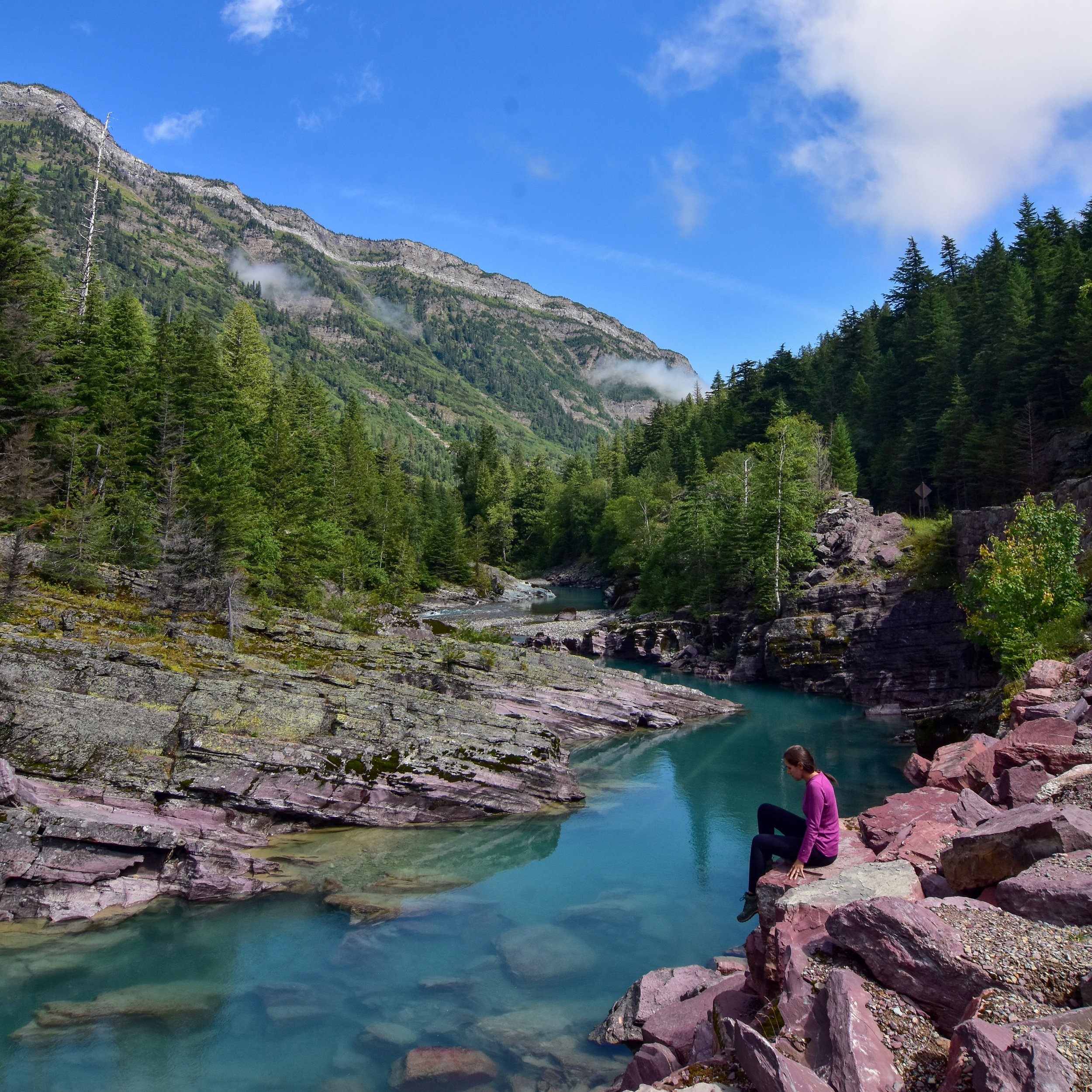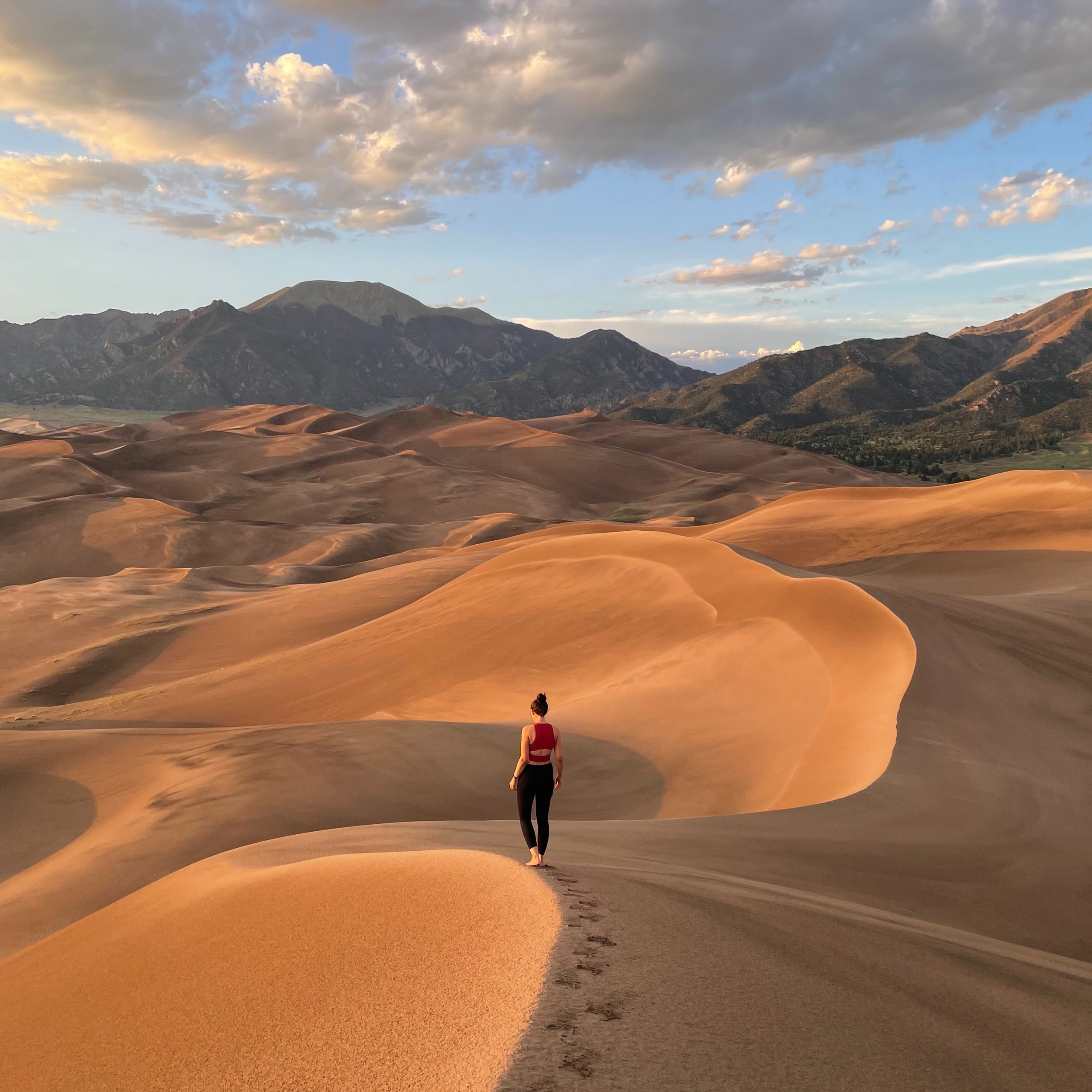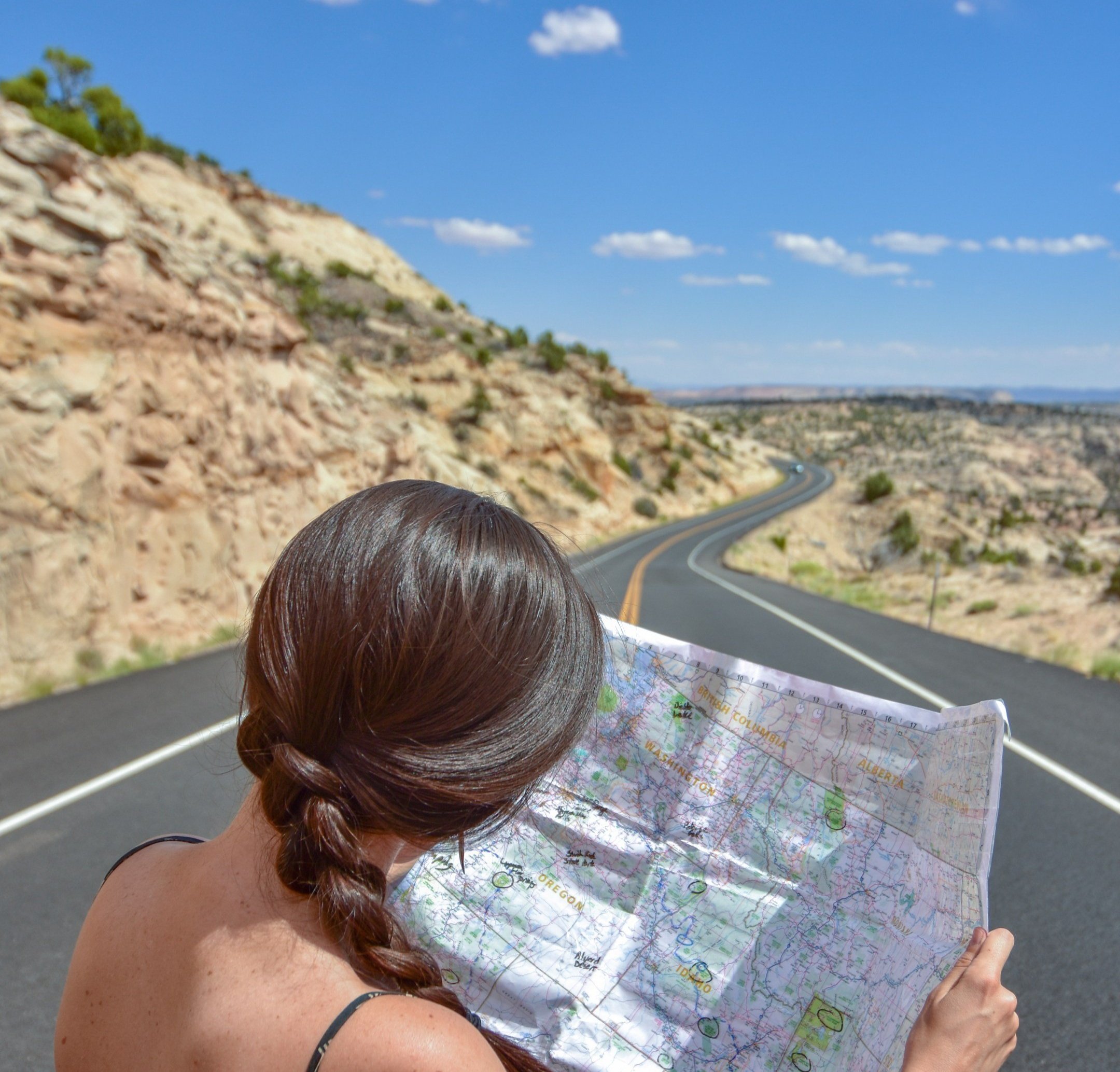GREAT BARRIER REEF LIVE-ABOARD TRIP: SCUBA DIVE AND ETHICALLY SWIM WITH WHALES IN AUSTRALIA
Seeing the Great Barrier Reef was at the top of our must-do list from the moment we started planning to visit Australia. With global warming destroying the reef even more rapidly than scientists had expected, we knew this would likely be our last chance to see it – but the chance to swim with whales in Australia was icing on the cake.
We agreed from the get-go that a day tour of the reef wouldn’t be enough. So we started hunting for a Great Barrier Reef live aboard trip, in which we could stay overnight on a boat for a few days in order to explore remote areas of the reef. Our research led us to Deep Sea Divers Den, a locally operated, family owned tour business. Their dwarf minke whale trip – a liveaboard expedition offering 16 dives in four days (for Aaron), plus the opportunity to swim with whales (for me) – sounded fantastic!
The minke whale trips only run from the beginning of June until mid-August, when the whales are passing through the area. Since we would be in Cairns right at the end of minke whale season, we knew we had to do it. It was a stretch for our budget, but we both agreed that seeing the reef before it’s gone was worth it – this wasn’t the trip we wanted to scrimp on.
As I write this, our live aboard boat is motoring back to Cairns after four incredible days on the reef, and I can absolutely say that it was a once-in-a-lifetime experience!
Reef-Bound!
Our room on the Ocean Quest, complete with an ocean view!
On our first day we were met at the marina by Sea Quest, Divers Den’s smaller boat that would take us and the 30-ish other guests on our first dives and then transport us to the Ocean Quest, the larger vessel which would be our home for the next four nights. We wasted no time in braving the choppy waters to reach our first dive site on the Great Barrier Reef.
As the friendly Divers Den staff went about investigating each guest’s level of diving experience, they were probably just as excited to learn about Aaron’s high level of proficiency as they were disappointed to learn that I’m just a snorkeler! Although we were both thrilled about getting up close and personal with the reef, Aaron is definitely more comfortable in the water than I am. He is fascinated by anything that lives in the sea and is basically a fish himself (when we met he was teaching swimming lessons and coaching a swim team). He even keeps an aquarium in his classroom and lugs it home for summer break to lovingly care for his tetras.
I, on the other hand, resisted all appeals to learn to dive for this trip. The idea of strapping a ton of equipment to myself and spending an hour deep in the ocean simply doesn’t appeal to me. Nonetheless, I wouldn’t have missed the chance to see this wonder of the world for myself, and I had a great time viewing the reef from my surface-level vantage point!
If you, like Aaron, are an enthusiastic scuba diver, you have definitely found your people at Deep Sea Divers Den. It was plenty of fun for this snorkeler to watch 30 adults transform into giddy schoolchildren as they donned their wetsuits and gear in preparation for their first dive on the Great Barrier Reef.
Every day of the trip was packed to the brim with a full schedule of four dives. Each dive was preceded by a briefing led by the divemasters, complete with detailed descriptions of the site and suggestions for specific flora and fauna to keep an eye out for.
While we explored the reef, the Divers Den staff somehow whipped up delicious and filling meals for the us to enjoy between each dive. We would peel off our wetsuits to wolf down a meal in the dining room, and then wriggle right back into them in time to discover the next dive site.
Each site offered something a little different from the last, as we motored further and further out to remote and little-known spots on the reef. Some sites were right along large crescents of reef wall, while others were submerged pinnacles of coral, invisible to anyone who didn’t know they were there. In contrast to other packed snorkeling and diving spots I’ve experienced around the world, in four days we never shared a site with another tour boat.
And the Great Barrier Reef didn’t disappoint. Before I even jumped in the water for the first time, I could see enormous spadefish gathering beside the boat as I pulled on my flippers on the dive deck. After just minutes in the water we were surrounded by schools of thousands of technicolor fish.
Just meters below the surface, a new world revealed itself. Whether diving or snorkeling, we were both overwhelmed by the stunning variety of sea life rivaling anything either of us has ever seen. Giant clams the size of people, fascinating coral formations, a variety of sharks, barracudas, turtles, sea snakes, you name it – it was like being inside a nature documentary. Under every nook and cranny, Aaron would find another octopus, shrimp, crab, or eel. He captured some fantastic shots during his dives – check out our 10 favorites that we shared the day we got back to dry land.
As though the divers weren’t getting enough time in the water, each packed day also ended with a night dive. Armed with a dive light, Aaron would slip into the black water to discover the world that comes alive on the reef after sunset.
As he was warned during the dive briefing, he soon found that giant trevally fish (which definitely earn their name since they’re almost as big as me) were eager to hunt in the glow of his flashlight. Again thanks to tips from the briefing, he endeavored to keep smaller fish on the outer edge of his circle of light so they wouldn’t be gobbled up by predators thanks to a herd of careless divers. A couple of night dives were particularly ideal for shark lovers, with gray and white tip reef sharks in abundance in the dark waters.
Each night we’d struggle to keep our eyes open long enough to enjoy dessert, then collapse into bed to rest up for another busy day on the reef.
Aaron heading out for a night dive (note the sharks waiting to welcome him!)
HOPING FOR WHALES
Despite the breathtaking sights we’d been privilege to on the Great Barrier Reef already, I know many in our group (myself included) were waiting anxiously for the whales to arrive. As our second day came to a close with only one distant sighting of a dwarf minke whale, I tried to keep my hopes for actually getting in the water with these beautiful creatures low.
Of course, despite Deep Sea Divers Den’s expertise, there’s no guarantee the minkes will cooperate. In fact, one of the reasons we chose to travel with this company was their clear commitment to respectful treatment of the whales. We’re very passionate about ethical travel, which, in the case of wildlife, often means we’re not in charge of the interactions. If you’re thinking of swimming with whales anywhere in the world (like getting up close with humpbacks in Tonga), make sure ahead of time that your tour is respectful of the animals!
We were pleasantly surprised to learn on our first day that Divers Den partners with the Minke Whale Project to protect, study, and respectfully interact with these whales. We even had a researcher from the project, Jules, on board to collect data and give talks to offer us insight into the minkes.
Dwarf minke whales were only discovered in the 1980s and very little is known about them. Jules was very clear that researchers don’t yet know for sure what the overall effects of human interactions are on these creatures. However, these whales are demonstrably curious and friendly towards people. Allowing tourists to experience them raises awareness and interest, which helps fund the study of these little-known animals.
So it seems that in this instance, a nice balance has been struck between tourism, science, and conservation. Only a few tour operators are cleared to hold a special license which allows them to conduct minke trips. Companies without this permit are not allowed to come within 100 meters of these whales. Tour operators like Deep Sea Divers Den, who have earned this permit, must follow a strict code of conduct that ensures their interactions with the minkes are respectful and sustainable.
The bottom line of this code of conduct was made very clear to us: No matter what, the whales initiate any and all contact. The boat will not chase them, and neither are swimmers allowed to approach them. Although of course we all wanted to see these mysterious creatures, I would have been horrified to learn that we were harassing them in any way. It was reassuring to hear the staff say over and over, “Hopefully we will see minkes, but it’s up to them if they decide they want us to.”
Fortunately for us, the minke whales were in a friendly mood.
An Unbelievable Experience
On the third day of our trip, we were anchored at a known minke hotspot, with Jules posted on the top deck with binoculars, scouting for surfacing whales. We had just finished breakfast when she spotted one right alongside the boat… then another… and before long we knew there were at least three whales swimming back and forth past the Ocean Quest.
I was in my wetsuit in a flash. As we had been instructed, I slid quietly into the water rather than jumping in to avoid creating a ruckus and bothering the whales. Scuba diving with the minkes is not allowed, so swimming with them is a snorkel-only experience. I pulled myself along the rope that had been strung along the surface of the water between the stern of the boat and a buoy about 100 meters away, doing my best not to use my flippers, as we had been coached that this could startle the whales. A few minutes later I reached the snorkeler ahead of me on the rope, gave myself the dedicated two meters of space between us, plunged my mask into the water, and settled in to wait. In order to have the least possible effect on the whales, swimmers are instructed to hold onto the line and lay flat on the surface, moving as little as possible, to allow for the minkes to initiate an interaction if they choose to.
We didn’t have long to wait. Just as I was starting to wonder if the minkes had moved on, I saw a 20-foot-long white and gray figure emerge from the endless blue emptiness ahead of me. I held my breath, scarcely able to believe that I was sharing the water with this gigantic creature, feeling a strange mix of awe and fear and reverence.
The minke glided slowly along below me and the other snorkelers, seemingly aware of our presence and having a look to see what we were up to. Seconds later it disappeared into the blue, leaving no trace to indicate it had been there at all.
Although that interaction would have been awesome enough, I could never have dreamed of what were in for during the rest of that day. First one whale, then two, then eventually five swam past us over and over again, gliding ever closer until I literally could have reached out and touched them. (Of course I didn’t, since swimmers absolutely aren’t allowed to touch the whales – although the biggest one swam so close to Aaron that it bumped him with its dorsal fin while Aaron tried to simultaneously get out of its way, take a photo, and not freak out).
Despite starting to shiver in my wetsuit, fighting to keep my snorkel clear in the choppy sea, and rubbing my fingers raw on the rope, I could not bring myself to get out of the water for the next two hours. For that entire time, there was never more than a minute or two between each pass by the family of whales.
With absolutely nothing enticing them to stay or preventing them from leaving, it seemed clear to me that they were interested in our presence – maybe even playing with us. Time after time, a medium-sized minke would swim past several meters below me, and after I had turned to watch it go by I would realize that the biggest whale had glided up right behind it and significantly higher – unsettingly close to me, in fact. I would repeatedly look down to find it directly below me and nearly within reaching distance, turned so that one giant eye could check me out up-close.
It was, without question, one of the most magical experiences of my life.
When we finally had to leave the water for lunch, I thought for sure our magical encounter was over. It was more than anything I could have hoped for and I didn’t expect the minkes to wait around for us. But as Aaron and I were sitting in our room clicking through the pictures we’d just taken, I looked up from the laptop to see a minke surface right next to our window!
Not willing to waste a moment of this opportunity, we were back up on deck pulling our wetsuits back on moments later. A couple of whales had stuck around, apparently not bored of examining us yet. This time we could hear them calling to each other once we hit the water, in what Jules later described to us as “Star Wars vocalizations” – three quick grunts followed by a longer groan (which really did sound like electronic tones from some futuristic weapon).
Pumped for another swim with the minke whales!
As the afternoon wore on and the minkes began to pass by the rope less frequently, we took their cues and headed back to the boat – physically exhausted but thrumming with excitement and awe at how lucky we’d just been.
For us, the icing on the cake was the knowledge that our trip contributed to the study of these little-known whales. During our interaction, Jules floated along the rope with specimen cups, gathering flakes of whale dandruff for testing. That evening she hosted a short lecture to share with us what scientists know about minke whales so far. Afterwards, she offered behavior description forms so that we could detail how we’d seen the whales acting, and she asked for copies of everyone’s photos to help identify individual whales. We were happy to oblige! (Although poor Jules has her work cut out for her to sift through the photos of 30 very excited tourists for something useful!)
Respecting the Great Barrier Reef
Throughout our Great Barrier Reef live aboard trip, we were impressed by Deep Sea Divers Den’s commitment to protecting the environment of the reef. With a $6 billion tourist industry and over two million visitors each year eager to get up close and personal, it would be easy to exploit this fragile ecosystem and choose profits over preservation. But we never got that feeling from Divers Den.
From the very first dive briefing and consistently throughout the trip, we were reminded not to touch any part of the reef (“Either you’ll hurt it or it will hurt you!”), and to treat the wildlife with respect. On Aaron’s first night dive, the guide even reminded divers not to wake sleeping turtles if they saw them.
And when it came to the opportunity to swim with whales in Australia, we couldn’t have asked for a better commitment to conservation and respect. Thanks to the combination of a great tour group and very clear guidelines from the Divers Den staff, we never saw anyone step a toe out of line. I watched our group members remind each other to turn their camera flashes off, dutifully hold on to the line rather than go swimming after the whales, and even do their utmost to get out of the way when a whale came within touching distance of its own accord. Having been on tours where animals are exploited and tourists are careless, it was exciting to see how conservation and tourism can in fact work so well together. (Our only complaint about Divers Den was that most of the staff seemed to smoke – a lot. They definitely kept it limited to a small outdoor area, but to me it really encroached upon the pristine natural beauty we were surrounded by).
I wish I could say that we’ll return to see more of the reef some day. But each year, less and less of it remains. Scientists estimate that close to half of the Great Barrier Reef’s coral has died over the past 18 months. So if the Great Barrier Reef is on your bucket list, now is the time to go.
But more importantly, now is also the time to start aggressively working to save it! And the best way to do that is to combat global warming. You can easily calculate your personal carbon footprint here. Then, take action to change whatever choices you’re making that contribute to climate change. Here are just a few ideas to get you started.
For us, this trip was an incredible amount of fun, but also a stark reminder of what we stand to lose if we all don’t start fighting for our planet. In fact, Aaron and I just took our own advice and re-calculated our current carbon footprint to investigate how we can do better. If you’re hoping to see the Great Barrier Reef yourself someday, leave us a comment and let us know what you’re doing to fight climate change!
Tips to Make the Most of A Great Barrier Reef Live Aboard Trip:
>> Bring clothes you don’t mind getting wet. You’ll be in and out of the water several times a day, so there’s no need for high fashion here. And don’t worry about shoes – you literally won’t wear them all week!
>> If you don’t own specialized underwater photography gear, splurge a little to rent some. We highly recommend Calypso Reef Imagery Centre – they were super easy to work with and we had zero problems with the equipment. (If you’re curious, Aaron hit the water with an Olympus TG-4 with underwater housing and an Ikelite strobe). It was absolutely worth the money! Without a flash, other divers weren’t able to pick up the vibrant colors far below the surface, and kept coming up with photos that were entirely a monochrome shade of blue. I would have been heartbroken if we’d taken the trip of a lifetime and returned with no pictures to show for it.
>> Pack a rashguard or reef-safe sunscreen to protect your skin without harming the reef. (We love Raw Elementssunscreen, and they’ll give you 10% off if you enter TWODUSTYTRAVELERS at checkout!)
>> This may be stating the obvious, but if you’re prone to seasickness, this probably isn’t the trip for you. The overnight haul back to Cairns after our final dive was particularly thrilling or sickening, depending on your perspective!
>> Although this trip was definitely tailored to scuba divers, the snorkeling was incredible, too. A couple of dive sites and the night dives were not ideal for snorkelers, but to me it was definitely still worth the trip (and the opportunity to swim with the minkes made up all the difference). If you’re interested in getting started diving, beginner divers can get certified as a part of this expedition.
>> Pack a warm layer. Don’t forget that Australia’s seasons are opposite to the United States, so July is actually winter! When we were there it was definitely cold at night and in the water.
>> Each trip is different. You can’t control the weather or the wildlife, so try to go in with no expectations!
You Might Also Like:
This post contains affiliate links. This means that if you decide to make a purchase through any of the links we recommend, we get a small commission at absolutely no cost to you. This helps with the cost of keeping this site running – so thank you in advance for clicking through! And not to worry, we don’t recommend anything we don’t fully believe in or that doesn’t align with our values.





